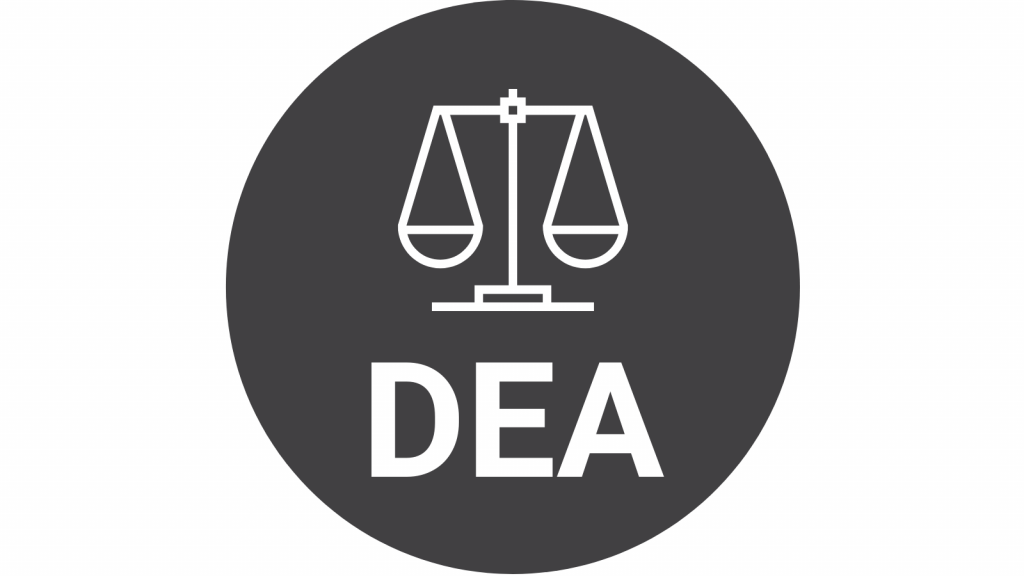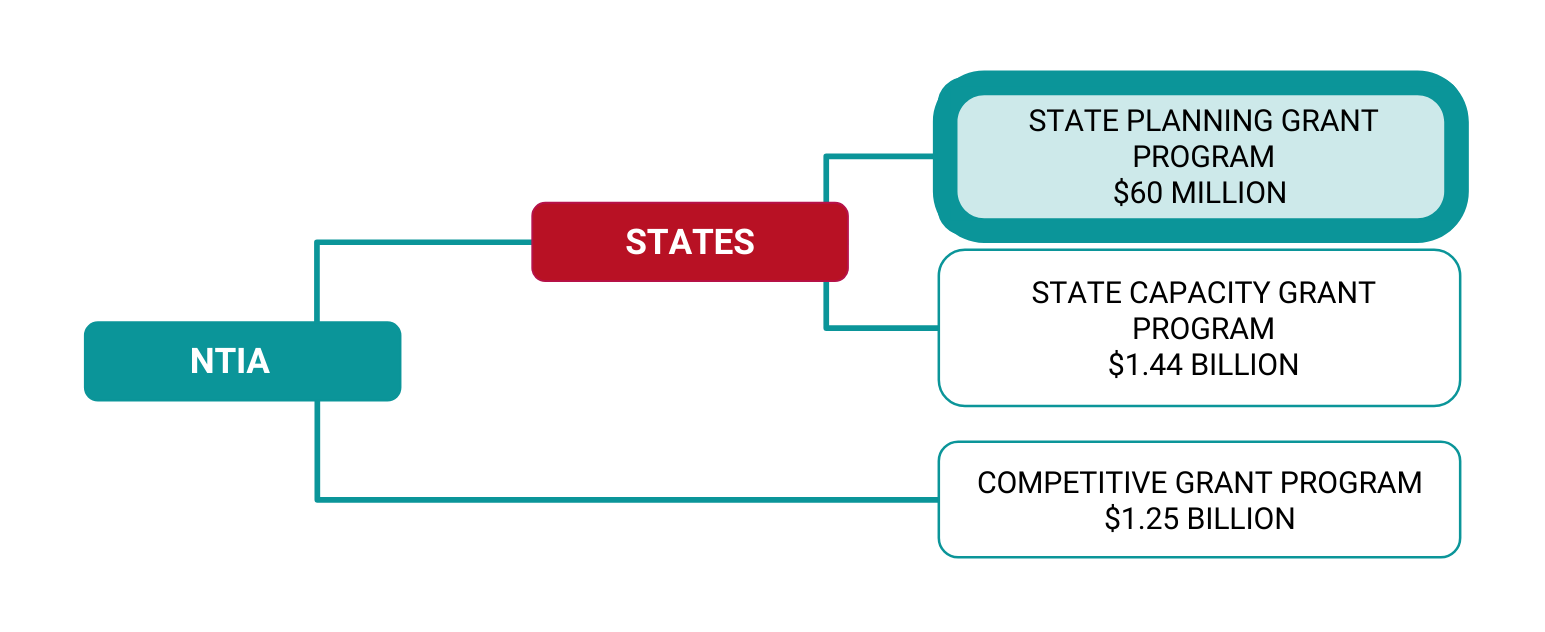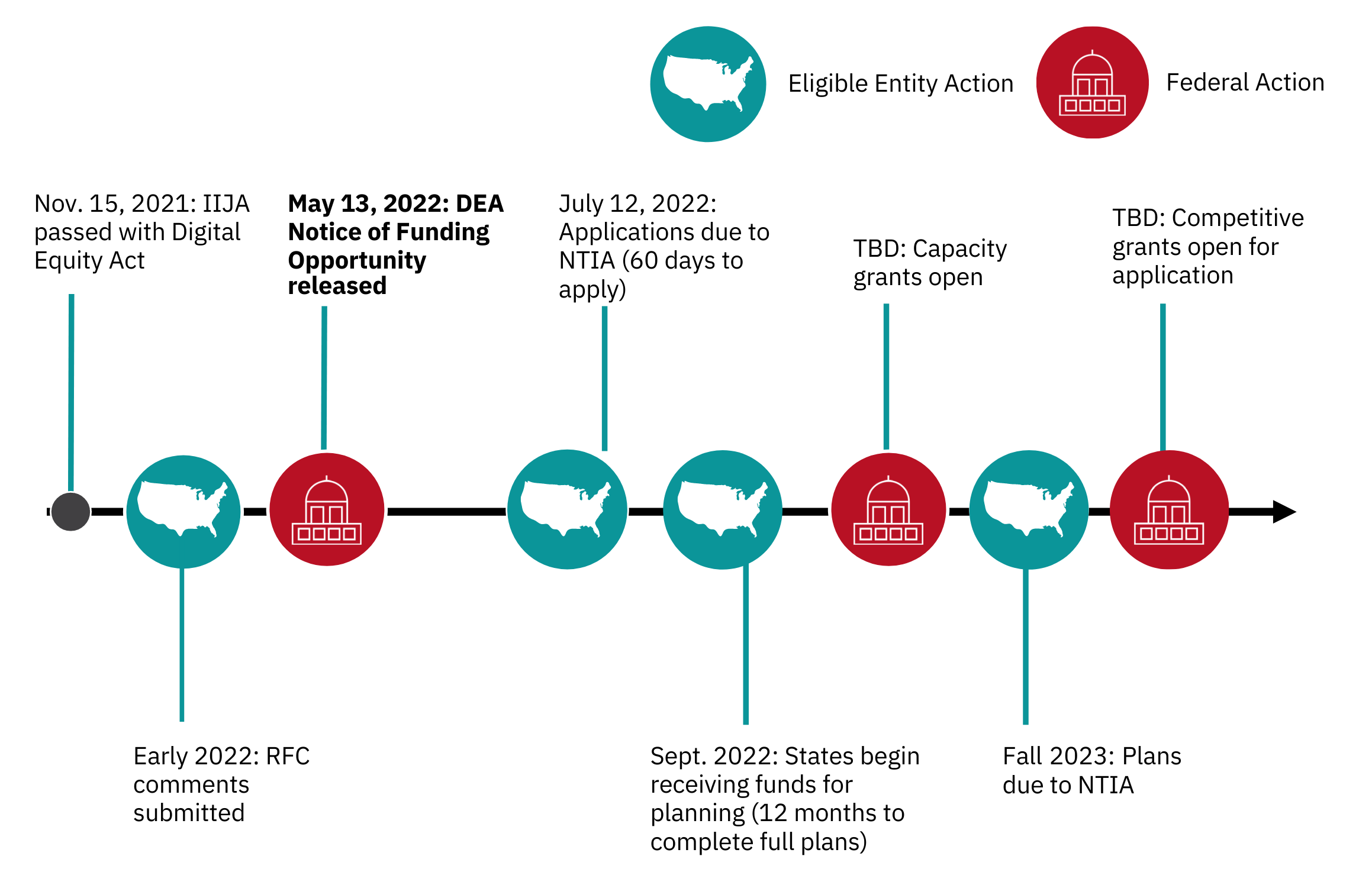NTIA Releases the Notice of Funding Opportunities for Three IIJA Programs Today
This is the second in a four-part series about the Infrastructure Investment and Jobs Act (IIJA) digital equity and broadband grant announcements from the National Telecommunications and Information Administration (NTIA). See the overarching explainer here, continue to check back here on our blog for more information, and register for our webinar, where we’ll dive into the BEAD and DEA NOFOs on Thursday, May 26, 3-4 p.m. ET.

Almost exactly three years since it was first introduced in Congress, the implementation of the Digital Equity Act (DEA) begins today with NTIA’s announcement of the opening of the first set of funds from the Digital Equity Act. The announcement comes by way of NTIA’s release of the first Notice of Funding Opportunity (NOFO) for the DEA.
The DEA creates two programs housed at the NTIA—the State Digital Equity Capacity Grant Program and the Digital Equity Competitive Grant Program.
The State Digital Equity Capacity Grant Program contains two types of grants: (1) planning and (2) capacity.
- The planning grants provide funding for states* to develop digital equity plans, which are required to be eligible for the capacity grants.
- Capacity grants are what they sound like—designed to provide states with the necessary support and capacity to fund the states’ digital inclusion priorities, strategies, initiatives, and implementation of their State Digital Equity Plans.
*In the context of this program, “state” means the 50 states, the District of Columbia, and Puerto Rico.

Today’s DEA NOFO is for the State Digital Equity Planning Grant Program, which provides $60 million for states, territories, and Tribal organizations to develop digital equity plans. The NOFOs for the State Digital Equity Capacity Grant Program and the Digital Equity Competitive Grant Program have not been released, and we do not yet know a timeframe for when they will be released.
Overall, the NOFO sticks pretty closely to the text of the DEA, but fleshes the language out a bit more in places, offering more guidance for applicants. NOFOs are dense and have a lot of ancillary material for the casual reader, as they contain things like where to send one’s application and how to apply for the specific codes needed to register for government systems. For the DEA NOFO the bulk of what is most interesting is found on pages 19-22.
After sifting through the NOFO, we identified these highlights for our community:
The NOFO opens up DEA planning dollars to Tribal organizations and territories (yay!)
Surprise! Not only can states, the District of Columbia, and Puerto Rico leverage the State Digital Equity Planning Grant Program to create digital equity plans, but also US territories and possessions, Indian Tribes, Alaska Native entities, and Native Hawaiian organizations can too (see page 3). The application process and grant amounts for Tribal organizations and territories will be slightly different than those for states.
NTIA is tentatively reserving $3 million to award grants of (tentatively) $150,000 to each of the following US territories and possessions: United States Virgin Islands, Guam, American Samoa, and the Commonwealth of the Northern Mariana Islands.
For Tribal organizations, NTIA is tentatively reserving $15 million to award grants to “Indian Tribes, Alaska Native entities, and Native Hawaiian organizations” to create Tribal digital equity plans or support Tribal participation in the creation of relevant State Digital Equity Plans. This means grant recipients can either use the funds to create their own digital equity plans or to fund expenses associated with participating in the planning process with the state(s) their Tribal land is located in. How much each Tribe receives will depend on how many apply but NTIA expects to allocate equally between $50,000 and $150,000 to each participating Indian Tribe, Alaska Native entity, and Native Hawaiian organization.
The NOFO explicitly encourages states to link their BEAD and DEA programs and planning processes
NTIA views the BEAD and DEA programs to be “holistically under a singular, unified objective of closing the digital divide” (see pages 6-7).
According to the NOFO, the BEAD 5-Year Action Plans must fully incorporate the State Digital Equity Plans and that those plans should be informed by and be complementary, sequenced, integrated, and intentionally linked to each other.
To link the plans, the NOFO says, at a minimum, states should:
- Ensure continuity between staff tasked with developing both plans.
- Create overlap between state DEA and BEAD planning teams.This means at least one individual working on the 5-Year Action plan should also be working on the Digital Equity Plan.
- Establish formal and direct communication and collaboration pathways between DEA and BEAD planning teams.
The NOFO provides more guidance on what should be in a “State Digital Equity Plan” (and it’s pretty good guidance at that)
In addition to what’s already outlined in the IIJA for what should be included in a State Digital Equity Plan, the NOFO (pages 21-22) says that at a minimum, the plans should also include the following:
- A digital equity vision statement
- A digital equity needs assessment
- An asset inventory of existing digital inclusion resources, programs, plans, and strategies
- A coordination and outreach strategy
- A description of how existing local (municipal, regional, and/or Tribal) digital equity plans will be incorporated into the State Digital Equity Plan
- A holistic implementation strategy that addresses the barriers to participation in the digital world, and includes measurable goals, objectives, and proposed core activities to address the needs of covered populations, establishes measures to ensure the plan’s sustainability and effectiveness, and (c) mechanisms for ongoing evaluation and update
- An explanation of how the implementation strategy addresses gaps in existing state, local, and private efforts to address the barriers to digital equity for covered populations
- A description of how the state will accomplish the implementation strategy by engaging and partnering with:
- Workforce agencies
- Community-based organizations and labor organizations
- Higher education institutions
- A timeline for implementation of the plan
- Outline of how the state will coordinate its DEA, BEAD, and other federal or private digital equity funding
The NOFO provides (tentative) dollar amounts that each state (the 50 states, Puerto Rico, and DC) can expect to receive for planning.
The amounts are calculated with a formula outlined in the IIJA. NTIA created the funding formula using the datasets required by the IIJA (see page 40 for the formula and how NTIA calculated the amounts). NTIA provided tentative amounts the states can expect to receive. The amounts are tentative because they are, by law, subject to state challenges.
Check out page 13 of the NOFO to see how much your state can expect to receive. Remember, the grants for Tribal organizations and territories other than Puerto Rico aren’t calculated under the same funding formula.
What’s Next?
Things will start to happen pretty quickly now that the NOFOs are released, but remember that the DEA is a five year program, so some parts of the program won’t be live for some time. According to NTIA’s new information sheet, the State Digital Equity Capacity Grant program will launch early 2024 and the Digital Equity Competitive Grant Program application will launch mid-2024.
That said, your state, Tribal organization, or territory may begin the planning process sooner so we recommend you reach out to your state leaders now to learn how you can be engaged in the planning process.
First, applications for the State Digital Equity Planning Grant Program will be due in 60 days or on July 12, 2022, 11:59pm EDT. US territories and possessions (other than Puerto Rico), Indian Tribes, Alaska Native entities, and Native Hawaiian organizations will need to submit a Letter of Intent by this same date.
In the application, each state will need to identify the official “Administering Entity” aka the designated entity who will lead the implementation of the DEA planning process and its implementation. Once this list is compiled, NTIA will publish the list and we’ll be sure to share it as well.
Next, NTIA will review the applications and LOIs and expects to begin awarding grants on September 29, 2022, at the earliest.
Once applicants receive their planning funds, they’ll have one year to create the plans. Those plans are required to access the State Digital Equity Capacity Grants that can be used to fund digital inclusion projects and programs.
You can read the NOFO here and register to attend our webinar on Thursday, May 26, 3-4 p.m. ET, here where we’ll break down how digital equity is embedded in all the NOFOs and answer all your questions

